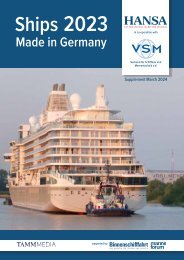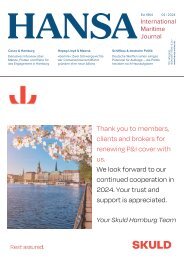HANSA 01-2021
Hull Performance & Coating · Svitzer · Yacht »Soaring« · Schifffahrtsaktien & Börsen · Harren & Partner · LNG in der Schulte-Gruppe · Berenberg Bank · Schiffsinspektionen
Hull Performance & Coating · Svitzer · Yacht »Soaring« · Schifffahrtsaktien & Börsen · Harren & Partner · LNG in der Schulte-Gruppe · Berenberg Bank · Schiffsinspektionen
Sie wollen auch ein ePaper? Erhöhen Sie die Reichweite Ihrer Titel.
YUMPU macht aus Druck-PDFs automatisch weboptimierte ePaper, die Google liebt.
MärKtE | MarKEtS<br />
Corona year ends on an upbeat tone<br />
Container and dry cargo trades are back on the growth path following a year of unseen<br />
turbulences. By Michael Hollmann<br />
Freight rates and vessel earnings across<br />
the container, dry bulk and mpp/heavylift<br />
segments were trending up in sync in<br />
the final weeks of 2020, spilling some urgently<br />
needed cash into the pockets of shipowners.<br />
as in previous months, container<br />
shipping reaped the biggest gains on the<br />
back of wide-spread equipment and slot<br />
shortages. Freight rates kept scaling new<br />
heights on a weekly basis, driven by steep<br />
increases on the Far East/Europe route.<br />
Spot rates for China/North continent shipments<br />
have doubled in a short space of time<br />
to around 5,000 $/FEU – an all-time high –<br />
and were expected to add another $1,500 as<br />
further general rate increases (Gri) became<br />
effective in the middle of december.<br />
The freight spikes even eclipse those<br />
during the China boom of the early<br />
2000’s, with anecdotal reports suggesting<br />
that some cargoes could be fixed at levels<br />
reaching 10,000 $/FEU, all surcharges<br />
included. lack of containers has been<br />
identified as the most important driver<br />
for rates these days. it seems the shortages<br />
had been coming for a while already<br />
as new container production in asia was<br />
stuck at levels below replacement needs<br />
from summer 2<strong>01</strong>9 to spring 2020, according<br />
to leading container lessor triton.<br />
Equipment orders only picked up in the<br />
second quarter and thus apparently too late<br />
for the massive rebound in container loadings<br />
in the third quarter. Factories are now<br />
full again, but it takes a few months for new<br />
boxes to deliver which means that larger<br />
volumes of extra equipment will only be<br />
phased in during this first quarter.<br />
Current cargo boom has legs...<br />
Shipping economists are still struggling<br />
to explain the current surge in cargo volumes.<br />
it is probably the combination of<br />
inventory rebuilding following the lockdowns<br />
of spring/summer 2020 and shift<br />
in consumer spending from services to<br />
physical goods, as the research division<br />
of Hamburg shipping group Peter dohle<br />
points out. add a bit more ineffciency<br />
and longer round-trip times for containers<br />
due to health and safety measures,<br />
and suddenly world container ship capacity<br />
is bursting at the seams. latest available<br />
cargo statistics (on a global scale) by<br />
data provider CtS date back to october.<br />
They show a 4.6% year-on-year increase<br />
in global tEU loadings during the month,<br />
buoyed by a near 26% burst in volumes on<br />
the Far East/North america route. The increase<br />
in Far East/Europe is »only« 7.0%<br />
year-on-year. However, against the background<br />
of more or less unchanged service<br />
capacity on this corridor, the current capacity<br />
squeeze makes absolute sense.<br />
Weitere Kennzahlen & Raten auf hansaonline.de:<br />
Container, Tanker, Bulker, MPP,<br />
Umschlag, Bunker … und vieles mehr<br />
Members of the Bremen Freight Forwarders<br />
association (VBSp) said in a web<br />
conference that they expect the tightness<br />
and elevated freight rates to continue possibly<br />
until spring. Even the reactivation of<br />
more charter tonnage and ships coming<br />
out of maintenance could not bring about<br />
any relaxation during the final weeks of<br />
2020. idle statistics by alphaliner implied<br />
that inactive container ship capacity had<br />
fallen to 1.2% by the end of November,<br />
against 5.7% a year earlier. Hamburg<br />
chartering firm Blue Net only considered<br />
three small feeder ships to be available<br />
at short notice. all the rest was tonnage<br />
berthed or drydocked at shipyards and<br />
vessels barred from trading due to sanctions<br />
or financial distress. little surprise,<br />
the container ship charter market surged<br />
to the highest levels since 2<strong>01</strong>1 after flirting<br />
with new lows in the second quarter.<br />
Geared bulkers and MPP up<br />
Market conditions in dry commodity<br />
shipping also took a positive turn towards<br />
the end of the year, with only the<br />
largest vessels (capesize) stuck at relatively<br />
low levels. The Baltic dry index posted a<br />
gain or more than 14% month-on-month<br />
as per middle of december, driven by improvements<br />
in panamax, supramax and<br />
handysize earnings.<br />
in fact, the smaller geared bulkers (supra/handy)<br />
saw spot earnings climb to the<br />
highest levels since october 2<strong>01</strong>9, with<br />
the 38,000 dwt type logging in more than<br />
12,100 $/day. Panamaxes rallied to a threemonth<br />
high of 13,400 $/day. as in the container<br />
trades, analysts highlighted a multitude<br />
of positive factors: a recovery in coal<br />
imports in China (from indonesia etc.), exceptionally<br />
strong grain liftings ex North<br />
america and – important for the handy<br />
trades – a boost in scrap import demand<br />
in turkey. latest steel production data finally<br />
shows a recovery in the rest of the<br />
world outside China, spurring iron ore<br />
and coking coal shipments on smaller tonnage.<br />
Meanwhile, the multipurpose/heavy<br />
lift segment witnessed steady improvements,<br />
too, with the toepfer index rate<br />
for 12,000 dwt F class vessels approaching<br />
$7,000 again. Chartering brokers and<br />
agents report severe capacity shortages for<br />
breakbulk shipments ex Europe while the<br />
high-end project cargo segment saw a notable<br />
cargo rush at the end of the year. n<br />
VIEWPOINT<br />
Bank-driven sales no<br />
longer »major influence«<br />
asset values in container shipping<br />
are firmly on the way up, with portfolio<br />
clear-outs and selling pressure<br />
by shipping banks now a thing of<br />
the past. Multipurpose ships could be<br />
next in line, says Christiane Witting,<br />
chief analyst at consultant and ship<br />
valuer ingenieurbüro Weselmann.<br />
This must be a year-end rallye also<br />
for you as ship valuers amid today’s<br />
busy S&P market?<br />
Christiane Wittig: We are reasonably<br />
busy, but not really more so than in<br />
other years. But the excitement we are<br />
seeing in the container market, that<br />
is something truly extraordinary, something<br />
we haven’t seen for many years.<br />
i don’t think anybody has seen<br />
it coming. Will it last? For now at<br />
least, the rally shows no signs of losing<br />
steam. and the supply side fun-<br />
8 HaNSa – international Maritime Journal <strong>01</strong> | <strong>2021</strong>


















